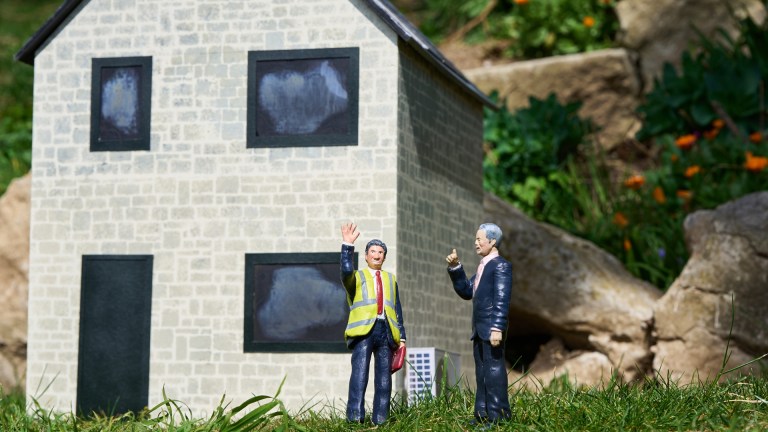Who is eligible for the disabled facilities grant?
Eligibility for the disabled facilities grant is primarily based on your needs as a disabled person, the type of work required, and your financial situation. The grant is designed to help anyone who has a disability that makes everyday tasks within the home difficult, whether you’re the homeowner or a tenant. Others looking to make changes to their property can apply for a home improvement grant.
If you own your home
If you own your home you are eligible to apply for the disabled facilities grant, as long as the adaptations will make a significant difference in your ability to live independently and safely. The grant is available to help cover the cost of necessary changes that help you to perform everyday tasks like bathing, cooking, or moving around your home with greater ease.
A local authority will typically arrange for an assessor or an occupational therapist to learn about your needs. They will visit your home, discuss the difficulties you’re experiencing and suggest adaptations which could be made.
The grant is means-tested, which means you might be eligible for the full amount of the grant if you’re on a low income or on certain benefits. But if you have a bigger financial safety net, you might be expected to contribute towards the cost of the changes in your home.
You can apply for the grant if you’re a homeowner or a tenant looking to make changes on behalf of someone else, but any means testing will be based on the income of the disabled person.
If you’re renting
You can still apply for the disabled facilities grant if you’re renting from a private landlord. You’ll need to get your landlord’s permission before any work can begin. The law doesn’t require them to agree to adaptations, but they will have to prove they have a good reason to refuse your request and that they aren’t discriminating against you.
Advertising helps fund Big Issue’s mission to end poverty
It’s important to note that the grant can only be used for permanent adaptations. This means that if you’re in a short-term tenancy or planning to move soon, the grant might not be the right option. However if you need help in a property you’re renting long-term or expect to stay in your current home for the foreseeable future, the grant could make a significant difference to your quality of life.
What can you use the disabled facilities grant for?
The disabled facilities grant is versatile and can be used for a wide range of home adaptations.
For many people this means adding features that make it easier to move around the home, such as widening doorways for wheelchair access or installing ramps. Others might need to install specialised equipment like a stairlift, or make changes to rooms such as the bathroom or kitchen. You may want to improve lighting to help with visibility or adapt the heating system to make sure your home stays at a comfortable temperature.
Some people use the grant to add an extra bedroom. This is particularly useful if you require a carer to stay overnight or if your existing bedroom isn’t accessible – some people might need to relocate their bedroom to the ground floor to avoid stairs, for example. The grant can cover the cost of building an extension or converting an existing space to create a bedroom that better suits your needs.
Mobility issues can make it difficult to navigate public transport or even walk to your car if it’s parked far from your home, so some people have driveways created outside their homes. This might involve paving an area of your garden, installing a ramp or widening the entrance for a wheelchair-accessible vehicle.
Your home might need more extensive changes, such as building an extension to house facilities like a wet room or accessible kitchen.
Advertising helps fund Big Issue’s mission to end poverty
The grant can help in situations where a home being in poor condition is making someone’s health condition worse. Researchers for Foundations, the national body for home improvement agencies, heard from people who had benefited from their local authority’s disabled facilities grant scheme.
Eloise, in her late 50s, lives alone in a one-bedroom ground floor flat in Somerset. While retraining for a new career at a local college, the government cut the funding for her course and she lost out on a paid work placement with no financial security net to fall back on. This had a detrimental effect on both her mental and physical health.
After the flat above Eloise had a significant leak – and didn’t make the necessary repairs with any speed – ceilings in her home collapsed and electrical wiring became unsafe. Her boiler stopped working too, leaving her without central heating or hot water which exacerbated her health conditions.
She couldn’t afford to fix any of the problems in her home and she was left feeling “depressed and alone” while her mobility worsened. But after a GP suggested she get in touch with the council, her flat was assessed and it was decided she should apply for a disabled facilities grant.
Eloise was successful, and the council covered the cost of a new level access shower for £8,358 – as well as a separate discretionary grant worth £7,797 to repair her ceilings and electrics, plus a replacement boiler.
During the process of applying for the grants, her local home improvement agency put Eloise in touch with other services to help her apply for benefits.
Advertising helps fund Big Issue’s mission to end poverty
The support she received was “completely life changing”, Eloise said, and “[restored] her dignity”. Now her flat is warm, her physical and mental health are better, and she is “proud of her home and feels she can have visitors once again”.
Do you have to pay back a disabled facilities grant?
One of the most important aspects of the disabled facilities grant is that it doesn’t usually need to be paid back. There are a few exceptions, however.
If the cost of the adaptations exceeds £5,000 and you sell your home within 10 years, you could be required to repay some or all of the grant. The repayment amount will depend on the value of the grant and the sale price of your home. It’s essential to check with your local council to understand the specific conditions in your area.
How to apply
The first thing you should do is contact your local council. They’ll provide you with the necessary forms and arrange for someone to assess your situation. The occupational therapist or assessor will visit your home, discuss your needs and make recommendations based on their findings.
Once the assessment is complete you’ll need to submit an application to your local council. This will include details of the work proposed, an estimated cost and information about your financial situation. The council will review your application and decide how much funding you’re eligible for – and they have to give you a decision within six months.
If your application is approved, the council will give you the grant to cover the cost of the work. In some cases the council may pay the contractor directly, while in others they might reimburse you once the work is done.
Advertising helps fund Big Issue’s mission to end poverty
It’s important to note that the application process can take time, so it’s a good idea to start early. If you’re unsure about any part of the process, your local council should be able to provide guidance and support.
“As a country, we have the oldest housing stock in Europe that was mostly built before accessible design was even considered,” said Christina McGill, director of social impact and external affairs for social housing provider Habinteg. “So the disabled facilities grant is a vital resource that should enable disabled and older people to maintain independence in their homes.
“However, as a social landlord with homes across England, we know that there are variations in grant-giving policies from one local authority to another which create a significant postcode lottery for residents.:
She added: “The national grant limit of £30,000 represents less and less value because of rising build costs and we think there is a strong argument for reviewing that maximum sum. We’re also aware that while some local authorities means test applicants for lower level grants, say of between £10,000 and £15,000, others don’t, so reviewing national policy to make this practice universal would make the system a lot more fair whilst allowing adaptations teams to focus their resources on the more complex grants.”
Do you have a story to tell or opinions to share about this? Get in touch and tell us more. Big Issue exists to give homeless and marginalised people the opportunity to earn an income. To support our work buy a copy of the magazine or get the app from the App Store or Google Play.










